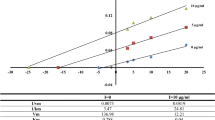Abstract
The efficacy of Aster sphathulifolius (AS) for evaluation of preventive potencies against diabetes and diabetic complications was analyzed by assessment of inhibitory effects against advanced glycation end-products (AGEs) formation, rat lens aldose reductase (RLAR), α-glucosidase activity, and scavenging effects against DPPH. The 50% ethanol extract showed the highest DPPH radical scavenging activity (82.38%) at a concentration of 100 μg/mL, exhibited the most potent AGEs formation inhibitory effect (93.88%) at a concentration of 200 μg/mL, showed the most potent RLAR inhibitory effect (86.44%) at a concentration of 11.11 μg/mL. The 95% ethanol extract showed a potent α-glucosidase inhibitory activity (19.16%) at a concentration of 1 mg/mL. The 50% ethanol extract value was 16.79%. The 50% ethanol extract exhibited the most potent antioxidant and preventive actions against diabetes and diabetic complications and can, thus, be a source of valuable compounds for prevention of diabetes and diabetic complications.
Similar content being viewed by others
References
Alberti KG, Zimmet PZ. Definition, diagnosis and classification of diabetes mellitus and its complications. Part 1: Diagnosis and classification of diabetes mellitus provisional report of a WHO consultation. Diabetic Med. 15: 539–553 (1998)
Heine RJ, Dekker JM. Beyond postprandial hyperglycaemia: Metabolic factors associated with cardiovascular disease. Diabetologia 45: 461–475 (2002)
Jones BJ, Brown BE, Loran JS, Edgerton D, Kennedy JF, Stead JA, Silk DB. Glucose absorption from starch hydrolysates in the human jejunum. Gut 24: 1152–1160 (1983)
Chung SS, Ho EC, Lam KS, Chung SK. Contribution of polyol pathway to diabetes-induced oxidative stress. J. Am. Soc. Nephrol. 14: S233–S236 (2003)
Reddy VP, Beyaz A. Inhibitors of the Maillard reaction and AGE breakers as therapeutics for multiple diseases. Drug Discov. Today 11: 646–654 (2006)
Park JY, Ha SW, King GL. The role of protein kinase C activation in the pathogenesis of diabetic vascular complications. Periton. Dialysis Int. 19(Suppl 2): S222–S227 (1999)
Buse MG. Hexosamines, insulin resistance, and the complications of diabetes: Current status. Am. J. Physiol.-Endoc. M 290: E1–E8 (2006)
Yabe-Nishimura C. Aldose reductase in glucose toxicity: A potential target for the prevention of diabetic complications. Pharmacol. Rev. 50: 21–33 (1998)
Brownlee M. The pathobiology of diabetic complications: A unifying mechanism. Diabetes 54: 1615–1625 (2005)
Jeon YE, Yin XF, Choi DB, Lim SS, Kang IJ, Shim JH. Inhibitory activity of aromadendrin from prickly pear (Opuntia ficus-indica) root on aldose reductase and the formation of advanced glycation end products. Food Sci. Biotechnol. 20: 1283–1288 (2011)
Ramasamy R, Vannucci SJ, Yan SS, Herold K, Yan SF, Schmidt AM. Advanced glycation end products and RAGE: A common thread in aging, diabetes, neurodegeneration, and inflammation. Glycobiology 15: 16R–28R (2005)
Ahmed N. Advanced glycation end product-Role in pathology of diabetic complications. Diabetes Res. Clin. Pr. 67: 3–21 (2005)
Wirasathien L, Pengsuparp T, Suttisri R, Ueda H, Moriyasu M, Kawanishi K. Inhibitors of aldose reductase and advanced glycation end-products formation from the leaves of Stelechocarpus cauliflorus R.E. Fr. Phytomedicine 14: 546–550 (2007)
Cui CB, Jeong SK, Lee YS, Lee SO, Kang IJ, Lim SS. Inhibitory activity of caffeoylquinic acids from the aerial parts Artemisia princeps on rat lens aldose reductase and on the formation of advanced glycation end products. J. Korean Soc. Appl. Biol. Chem. 52: 655–662 (2009)
Hsieh PC, Huang GJ, Ho YL, Lin YH, Huang SS, Chiang YC, Tseng MC, Chang YS. Activities of antioxidants, α-glucosidase inhibitors, and aldose reductase inhibitors of the aqueous extracts of four Flemingia species in Taiwan. Bot. Stud. 51: 293–302 (2010)
Kim TJ. Wild Flowers of Korea. Kugil Media, Seoul, Korea. p. 232 (1996)
Lee CB. Illustrated Flora of Korea. Hyangmoonsa, Seoul, Korea. p. 740 (1999)
Choi SZ, Kwon HC, Choi SU, Lee KR. Five new labdane diterpenes from Aster oharai. J. Nat. Prod. 65: 1102–1106 (2002)
Jung CM, Kwon HC, Seo JJ, Ohizumi Y, Matsunaga K, Saito S, Lee KR. Two new monoterpene peroxide glycosides from Aster scaber. Chem. Pharm. Bull. 49: 912–914 (2001)
Lee SO, Choi SZ, Choi SU, Lee KC, Chin YW, Kim J, Kim YC, Lee KR. Labdane diterpenes from Aster spathulifolius and their cytotoxic effects on human cancer cell lines. J. Nat. Prod. 68: 1471–1474 (2005)
Chon SU, Kim YM, Kim DK, Heo BG, Cho JY. Phytotoxic effect, DPPH radical scavenging activity, and chlorogenic acid level of methanol extracts from aerial parts of several Korean salad plants. Korean J. Plant Res. 19: 405–410 (2006)
Jung HA, Jung YJ, Yoon NY, Jeong DM, Bae HJ, Kim DW, Na DH, Choi JS. Inhibitory effects of Nelumbo nucifera leaves on rat lens aldose reductase, advanced glycation endproducts formation, and oxidative stress. Food Chem. Toxicol. 46: 3818–3826 (2008)
Kim HS, Park UY, Seong YH. Inhibitory effects of ginseng components on rat lens aldose reductase activities. Korean J. Ginseng Sci. 20: 106–110 (1996)
Hayman S, Kinoshita JH. Isolation and properties of lens aldose reductase. J. Biol. Chem. 240: 877–882 (1965)
Matsui T, Yoshimoto C, Osajima K, Oki T, Osajima Y. In vitro survey of alpha-glucosidase inhibitory food components. Biosci. Biotech. Bioch. 60: 2019–2022 (1996)
Matough FA, Budin SB, Hamid ZA, Alwahaibi N, Mohamed J. The role of oxidative stress and antioxidants in diabetic complications. Sultan Qaboos Univ. Med. J. 12: 5–18 (2012)
Lee HS, Hong CO, Lee KW. Advanced glycation endproduct-induced diabetic complications. Food Sci. Biotechnol. 17: 1131–1138 (2008)
Tang WH, Martin KA, Hwa J. Aldose reductase, oxidative stress, and diabetic mellitus. Front. Pharmacol. 3: 87 (2012)
Krentz AJ, Bailey CJ. Oral antidiabetic agents: Current role in type 2 diabetes mellitus. Drugs 65: 385–411 (2005)
Author information
Authors and Affiliations
Corresponding author
Rights and permissions
About this article
Cite this article
Yin, X.F., Jeon, Y.E., Chung, H.C. et al. In vitro efficacy evaluation for prevention of diabetes and diabetic complications using Aster sphathulifolius . Food Sci Biotechnol 24, 301–306 (2015). https://doi.org/10.1007/s10068-015-0040-0
Received:
Revised:
Accepted:
Published:
Issue Date:
DOI: https://doi.org/10.1007/s10068-015-0040-0




